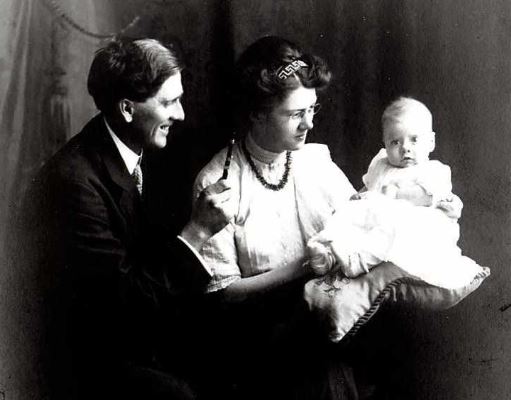In a letter from April 30, 1970, to Maisie Hewlett (1887-1974), McLuhan recalled his family’s time in Alberta:
I am really grateful to Elizabeth (Trott) Cera for suggesting that you send your quite memorable memoir1 to me. The scenes and the events coincide with the life of my parents in the West before [World] War I. After homesteading [in Mannville, Alberta, 100 miles east of Edmonton,] they went to Edmonton [early in 1911]. My father was in a real estate firm until he joined the army in 1914. I left Edmonton [for Winnipeg] when I was four [in 1915], but remember much of it very vividly. (Letters 405)
There is a picture of McLuhan with his parents in 1911, age six months, taking in the Edmonton scene that he will long recollect:
- A Too Short Yesterday (1970). One of Kaye Rowe’s ‘People Watching’ columns in the Brandon Sun (May 28, 1970, p 12) shows that her friend Elizabeth (Trott) Cera must have suggested to Hewlett that a copy go to Rowe as well as to McLuhan: “Cannington Manor, a magnet for legends on the Prairies, has housed since its beginning in the 1880s, assorted people with a touch of epic. The current official recorder is a bright-eyed lady who remains in proper Victorian fashion behind a trio of initials — A.E.M. Hewlett — author of a spritely sequence of 14 years of farming on the acres originally turned by the Cannington Manor squires and 14 years of farm-wife life under its leaking Mansard roof. The title of A Too Short Yesterday (published by The Western Producer Press at Saskatoon) is abstracted from a slender poem in which the lines occur: “Lord, I am too little for a grand eternity. I would hear children’s voices, a spoon beating upon a table; mine I would the way I travelled, loved and lost in a too short yesterday.” One day a few years ago when widowed and her sons grown tall, and with families of their own, she went back the few miles from Carlyle Sask., where she chooses to live in summer, to the Manor and up to the attic. Despite the fact that the house had been used for grain-storage for years, the attic and its contents had remained undisturbed. She found the old wooden trunk, metal-bound, painted and initialled, that she had purchased for 10 shillings in Charing Cross Road in 1911. It had carried her clothing and books when, under the aegis of the British Women’s Emigration Society, she decided to teach in Canada. “You will regret it!” the headmaster of the Yorkshire school where she had taught for three years had warned. Nonsense! The English girl met the incredible challenges of semi-pioneering life, eventually wrote a column for 20 years for The Saskatchewan Farmer under the title, ‘Down On The Farm’. She became, in effect, the (Manitoba journalist) Amy Roe of her province. The only child of a chemist’s widow, leaving mother was the major wrench. But each week she wrote faithfully; the letters were lovingly saved, bundled as to dates and years. Decades later when her mother died the letters were returned with other effects she requested. Every page of the letters is a mirror of the ups and downs of one family in a life difficult to be imagined by her grandchildren. For them — 12 in all plus one great-grandchild — she recaptures the everyday living on a prairie farm, admittedly, no ordinary farm. Earlier assignments by the University of Saskatchewan to Mrs. Hewlett involved (recording) tales based on information collected from over 50 of the early participants of Cannington Manor’s exotic settlement. It began in 1882 with Capt. Edward Mitchell Pierce and associates, a group of upper middle-class English who resolved to re-establish in Saskatchewan’s broad acres the same kind of life they had lived in England. They bred horses, rode to hounds, dressed for dinner on festive occasions and imported younger sons of friends and associates as “apprentices to agriculture” to learn farming from the ground up. Their experiment dwindled and died under the impact of the First World War when the members scattered and Mrs. Hewlett and her husband (designated as “Richard Land”), a ship-board acquaintance but one of the 1890 Cannington inhabitants, took up residence in the manor house. The letters give the record a lively sense of immediacy whether the excitement of the day is the arrival of her wedding gown or a listing of the callers and impromptu dinner guests (anyone passing by, from “Mountie” to horse- trader). Mrs. Hewlett writes with verve and color, the same qualities she manages to impart to her water colors. As a practising artist at 83 she continues to merit one-man shows in the province of her adoption. Her water colors have also hung in the art gallery at Laguna Beach, the artists’ colony resort where she spends several months every winter. Last year when friend Mrs. Duncan Campbell called on the author-painter at the Seas Motel, she discovered the lady clothes-pegging her morning’s sketches on the line to dry. The book bursts with the vitality of elements familiar to our region, with horses and crops and financial worries, with children growing and neighborliness and the hum of cream separator, sewing machine or reaper. She splashes on the colors of skies and spring burgeoning and mauve shadowings on sculptured snow. It makes fascinating reading, a too-short 161 pages in recall of A Too Short Yesterday.” ↩
